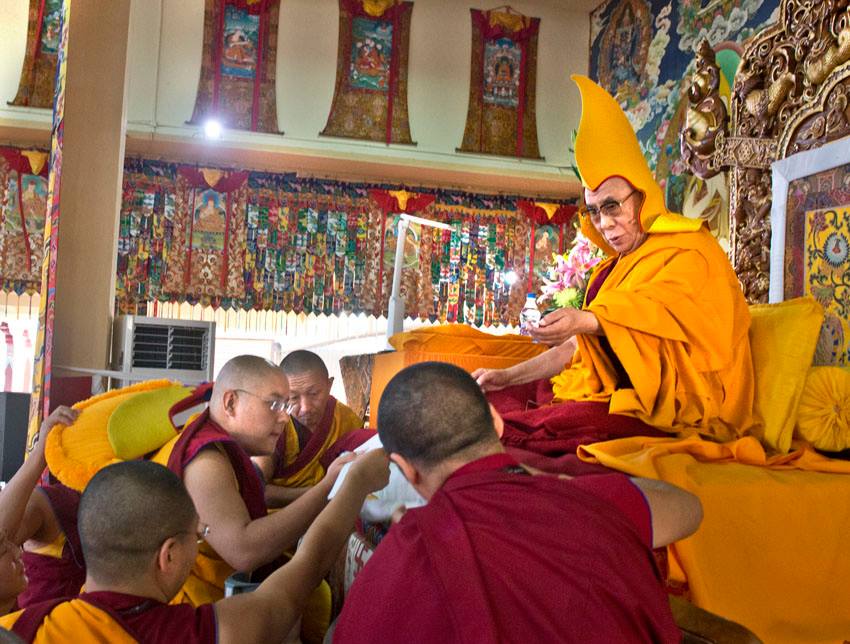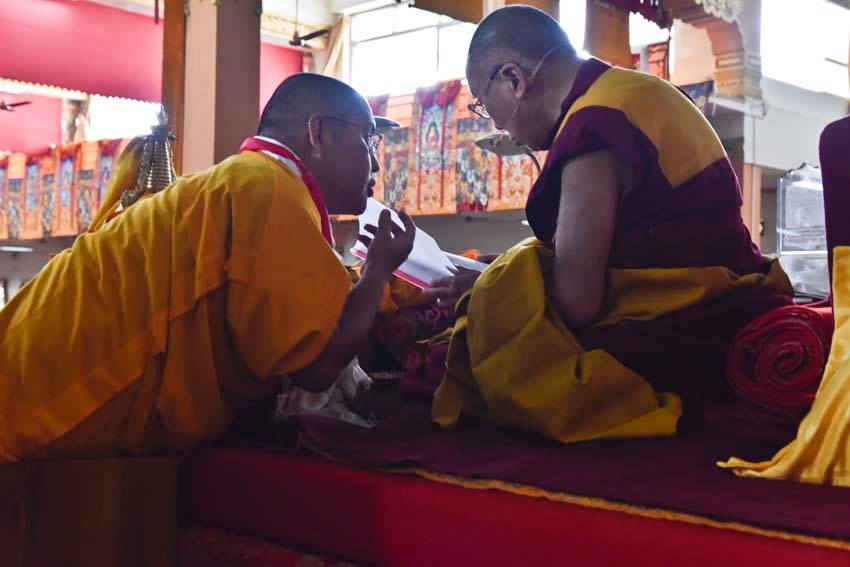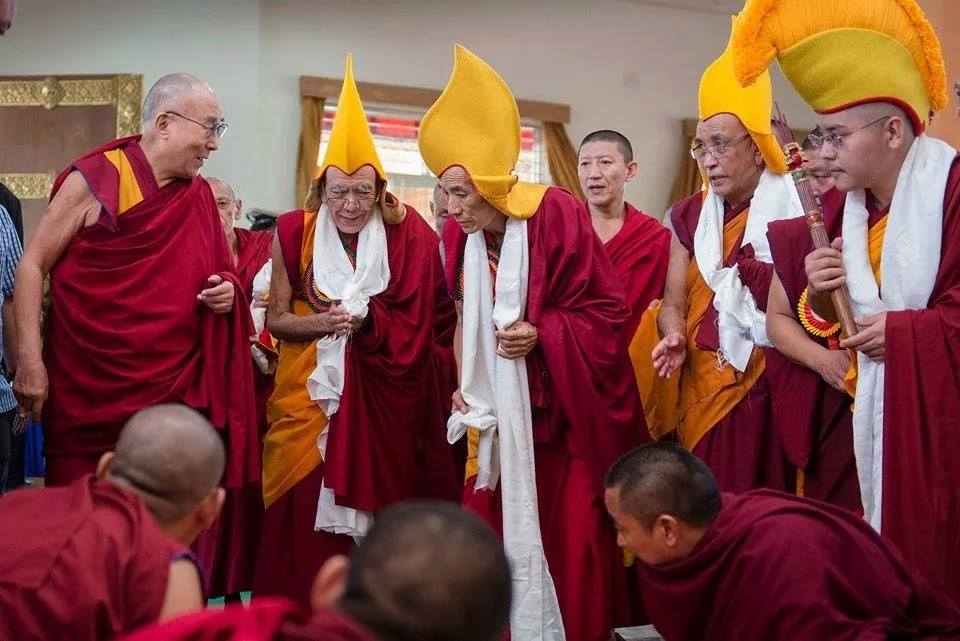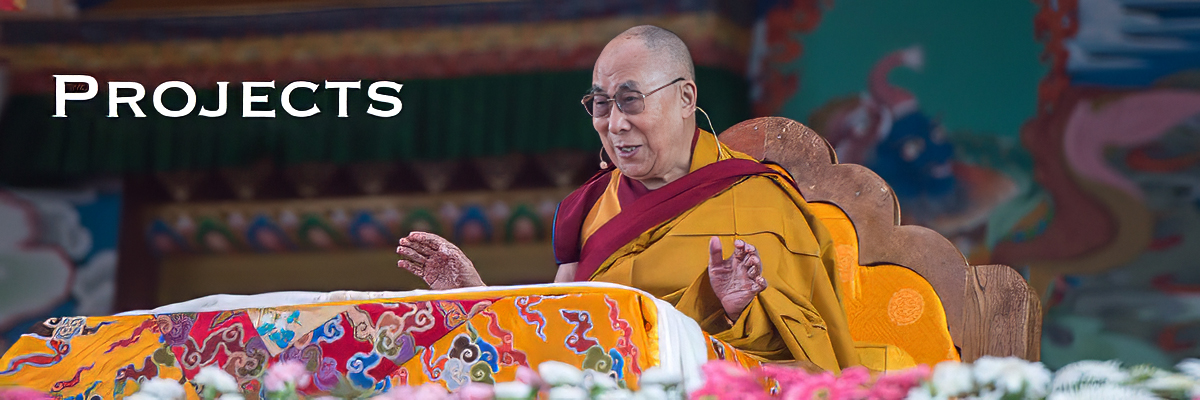Stages of the Path to Enlightenment Teachings
In 2002 H.E. Ling Rinpoche requested His Holiness the Dalai Lama to give teachings on the 18 Jangchup Lamrim texts (Stages of the Path to Enlightenment). In 2011 Gaden Shartse Monastery made the same request. His Holiness accepted their requests and gave teachings over four years at the Gelugpa seats of learning in South India — Sera, Drepung, Gaden and Tashi Lhunpo monasteries.
The Jangchup Lamrim Teaching Organizing Committee was guided by Ling Rinpoche with Professor Samdhong Rinpoche as the Chief Advisor. These historic teachings began in 2012 at Gaden and Drepung monasteries and continued each year until the 2015 teachings at Tashi Lhunpo monastery. www.jangchuplamrim.org
Teachings Multimedia Archive
2015 Teachings – Audio & Video >
2014 Teachings – Audio & Video >
2013 Teachings – Audio & Video >
2012 Teachings – Audio & Video >

Over the four years of teachings, His Holiness the 14th Dalai Lama kindly bestowed rare and precious transmissions of the 18 Great Lamrim Texts, with His own unique and distinctive commentaries. More than 30,000 people attended each year; while hundreds of thousands watched worldwide, via live webcast.

The Lamrim Tradition
Lamrim refers to the group of teachings developed in Tibet on the root text A Lamp for the Path to Enlightenment. It was written by Atisa, the great Indian master who came to Tibet in the 11th Century and founded the Kadam tradition. Many Kadam and later Gelug masters wrote Lamrim commentaries. The most famous is Tsongkhapa’s master work, the Great Stages of the Path to Enlightenment (Lamrim Chenmo), which is a core teaching of the Gelug school.

Although monks are not taught Lamrim in the Gelug monastic curriculum until later in their studies, it is often the first teaching given to students today, who are not monks. The importance of Atisa’s first Lamrim text is to put the Buddha’s teachings into logical order with step-by-step instructions that can be understood and practiced by anyone who wishes to follow the Buddhist path to Enlightenment. Atisha relied on what Buddha taught himself as well as the living oral traditions of these teachings he brought to Tibet. Unbroken linages passed down from Buddha to the great Indian scholar yogis, such as Asanga and Nagarjuna, down to Atisha’s own spiritual masters. These extremely important oral teachings still exist today through great contemporary lamas, including His Holiness the Dalai Lama.
The 18 Jangchup Lamrim Texts
- Lamp for the Path to Enlightenment by Atisha
- The Great Treatise on the Stages of the Path to Enlightenment by Tsongkhapa
- The Medium Treatise on the Stages of the Path to Enlightenment by Tsongkhapa
- The Concise Treatise on the Stages of the Path to Enlightenment by Tsongkhapa
- The Essence of Refined Gold — Stages of the Path to Enlightenment by His Holiness the 3rd Dalai Lama, Sonam Gyatso
- The Easy Path — Stages of the Path to Enlightenment by Panchen Lobsang Chokyi Gyaltsen
- The Sacred Words of Manjushri — Stages of the Path to Enlightenment by His Holiness the 5th Dalai Lama, Lobsang Gyatso
- The Swift Path — Stages of the Path to Enlightenment by Panchen Lobsang Yeshe
- Essence of Fine Speech — Stages to the Path of Enlightenment by Ngawang Drakpa of Dagpo
- The Three Principle Aspects of the Path by Tsongkhapa
- Foundation of All Good Qualities by Tsongkhapa
- Destiny Fulfilled: The Spiritual Biography of Lama Tsongkhapa by Tsongkhapa
- The Essence of Nectar — Stages of the Path to Enlightenment by Kongpo Lama Yeshe Tsondru
- The Southern Lineage — Stages of the Path to Enlightenment by Gendun Jamyang
- Zhamar Pandita’s Treatise on the Stages of the Path to Enlightenment by the 4th Amdo Zhamar, Gendun Tenzin Gyatso
- Zhamar Pandita’s Treatise on Special Insight by the 4th Amdo Zhamar, Gendun Tenzin Gyatso
- Liberation in the Palm of One’s Hand spoken by Pabongka Rinpoche and compiled by Trijang Rinpoche
- Text Outline for the Medium Treatise on the Stages of the Path to Enlightenment by Trijang Rinpoche

